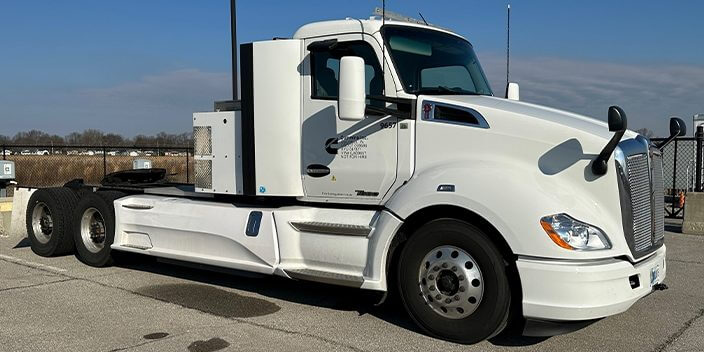Purdue researchers collaborate with Cummins to develop wireless charging technology for heavy-duty vehicles

WEST LAFAYETTE, Ind. — As part of a $5 million award from the United States Department of Energy’s Vehicle Technologies Office, Purdue researchers from the Elmore Family School of Electrical and Computer Engineering are collaborating with Cummins Inc., Oak Ridge National Laboratory (ORNL) and Walmart to develop wireless charging technology for electric heavy-duty vehicles such as Class 8 trucks (tractor-trailers).
As the project lead, Cummins will first develop a 750kW wireless charging system with ORNL. After that, Cummins will integrate the system into a Class 8 electric truck. Purdue will test the technology and ensure its compatibility with other types of wireless charging systems. Once the research, development and testing are complete, Walmart will demonstrate the system in a real-world fleet operation.
Tractor-trailers with regional routes are ideal candidates for electrification because they travel predictable and consistent distances. However, wired charging, which currently dominates the electric vehicle infrastructure, poses logistical and safety challenges. The cables that support very high-power (VHP) charging are heavy and cumbersome to manipulate. To combat this problem, Cummins — in partnership with Purdue, ORNL and Walmart — are developing a stationary wireless VHP charging system that will charge heavy-duty vehicles with minimal intervention from fleet workers.
Dionysios Aliprantis, professor of electrical and computer engineering and Purdue’s principal investigator for this project, compares this system to a cellphone charging station.
“The basic idea is that instead of charging your electric vehicle with a cable, you would charge it wirelessly, much like how you can place a phone on a charging pad,” Aliprantis said. “In this case, the driver would simply park the tractor-trailer on top of the system that would then charge it over 15-20 minutes.”
This wireless charging system features a polyphase topology, meaning that it utilizes multiple flows of electric current that work together to generate power. Most existing charging systems are single phase, which use only one stream of current. A polyphase system can transfer the same amount of electric energy much faster through a smaller surface area than single-phase systems.
According to the project’s principal investigator Dr. Minyu Cai, technical manager in hybrid and electrification technologies at Cummins R&T and a Purdue alumnus, high-power wireless charging allows commercial vehicles to have a smaller on-board battery, reduces charging time to enable double shifts (supporting around-the-clock operations) and offers driver convenience and safety. “Our goal is to develop a wireless charging system for electric trucks that is faster, cheaper and more compact than the state-of-the-art,” Cai said.
Since a variety of systems exist across the electric vehicle infrastructure, Purdue’s primary role is to test the interoperability of this project’s technology with other types of wireless charging apparatuses and study their impact on the power grid.
Steven D. Pekarek, the Dr. Edmund O. Schweitzer, III Professor of Electrical and Computer Engineering, says that a robust infrastructure and compatibility between different types of systems is key to increasing the number of electric vehicles on the road.
“The overall goal is to address the issues of cost and range anxiety associated with electric vehicles. That anxiety is exacerbated in heavy-duty vehicles simply because of the demand of power that you’re needing and the cost of the battery that’s required,” Pekarek said. “The focus is really to develop technologies that enable ubiquitous charging. If that’s successful, you can reduce the cost of the vehicles and improve the electric vehicle infrastructure.”
Aliprantis, Pekarek and Aaron Brovont, research assistant professor of electrical and computer engineering at Purdue, will test Cummins and ORNL’s technology with their own system that was designed for dynamic wireless power transfer, meaning that it can charge a vehicle while it’s in motion. This system is a part of a collaboration with the Indiana Department of Transportation through Advancing Sustainability through Powered Infrastructure for Roadway Electrification, a multi-university, public-private collaboration funded by the National Science Foundation and led by Utah State University. The dynamic system features charging coils that will be installed across a segment of U.S. Route 231 in Indiana. These coils charge electric vehicles as they drive over them.
The transportation sector is one of the largest contributors to greenhouse gas emissions in the U.S., so vehicle electrification is critical to reducing those pollutants. However, without a more expansive and systematic charging infrastructure, widespread adoption of electric vehicles will remain difficult. Ultimately, this project aims to improve the transportation sector by making the electric vehicle landscape more accessible.
“Research on vehicle electrification isn’t just about taking vehicles and removing the gasoline,” Brovont said. “It’s about making the transportation sector more eco- and human-friendly.”
About Purdue University
Purdue University is a public research institution demonstrating excellence at scale. Ranked among top 10 public universities and with two colleges in the top four in the United States, Purdue discovers and disseminates knowledge with a quality and at a scale second to none. More than 105,000 students study at Purdue across modalities and locations, including nearly 50,000 in person on the West Lafayette campus. Committed to affordability and accessibility, Purdue’s main campus has frozen tuition 13 years in a row. See how Purdue never stops in the persistent pursuit of the next giant leap — including its first comprehensive urban campus in Indianapolis, the new Mitchell E. Daniels, Jr. School of Business, and Purdue Computes — at https://www.purdue.edu/president/strategic-initiatives.
Writer/Media contact: Lindsey Macdonald, macdonl@purdue.edu
Sources: Dionysios Aliprantis, dionysios@purdue.edu
Steven D. Pekarek, spekarek@purdue.edu
Aaron Brovont , brovont@purdue.edu
Minyu Cai, Cummins Inc.